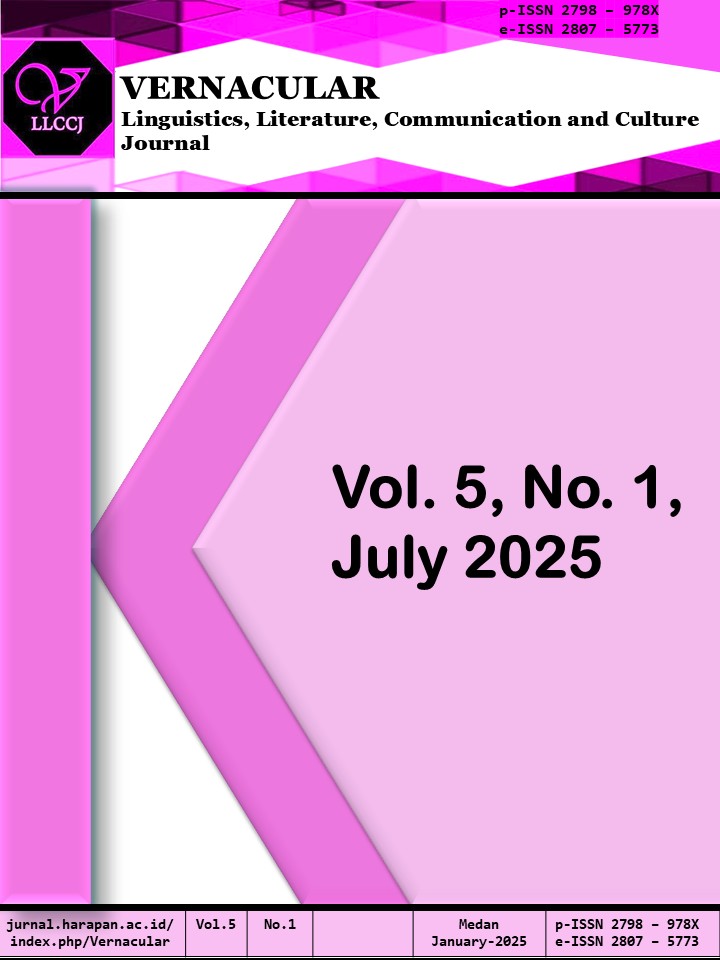PENGGUNAAN VERBA AGEMASU DAN MORAIMASU DALAM BAHASA JEPANG
PENGGUNAAN VERBA AGEMASU DAN MORAIMASU DALAM BAHASA JEPANG
DOI:
https://doi.org/10.35447/vernacular.v5i1.1160Keywords:
Agemasu , Japanese, Language, Moraimasu, VerbsAbstract
Agemasu and moraimasu are two Japanese verbs that are often used in the context of giving and receiving. This study aims to find out the meaning of agemasu and moraimasu verbs, find out the use and function of agemasu and moraimasu by using the literature method. Agemasu ( あげます) means ‘to give’ and is used when someone gives something to another person, usually in the context of giving something from the speaker to another person or from someone of higher status to a lower one. Moraimasu (もらいます) means ‘to receive’ and is used when someone receives something from another person. It is usually used in contexts where the receiver is lower in status than the giver, or in more informal situations. Both are important in everyday communication as they help to illustrate social relationships and interactions in Japanese culture, which places great importance on hierarchy and social etiquette. The verb ‘agemasu’ focuses on the act of giving from the perspective of the giver, while ‘moraimasu’ focuses on the act of receiving from the perspective of the receiver. In the same situation, ‘agemasu’ would be used by the giver and ‘moraimasu’ by the receiver, yet both speak of the same action from different perspectives. The verb moraimasu means to receive. The receiver here can be the speaker or someone close to the speaker. It can also come in the form itadakimasu, if the giver is of a higher social level.
Downloads
References
Diner, L. (2009). Efektivitas Media Gambar Dalam Pengajaran Kuremasu Pada Mata Kuliah Struktur (Bunpoo) Bahasa Jepang. Lembaran Ilmu Kependidikan, 38(1), 35–39.
Humairah, H., & Putri, M. A. (2019). Korelasi Kebiasaan Menonton Drama Dengan Kemampuan Goi Mahasiswa Tahun Masuk 2018 Prodi Pendidikan Bahasa Jepang Universitas Negeri Padang. Omiyage : Jurnal Bahasa Dan Pembelajaran Bahasa Jepang, 2(2), 1–5. https://doi.org/10.24036/omg.v2i2.132
Krisnawa, K. B. (2023). Pembelajaran Bahasa Jepang di Lembaga Kursus dan Pelatihan ( LKP ) Babaking Course. 3(1).
Kurniawan, A. (2014). Panduan Lengkap Tata Bahasa Jepang. Yogyakarta: Sketsa. Mulya, I. G. B. A. (2020). Analisis Makna Verba Majemuk Owaru Dalam Bahasa Jepang. Jurnal Pendidikan Bahasa Jepang Undiksha, 6(3), 287.
https://doi.org/10.23887/jpbj.v6i3.25593
Padmadewi, Ni Nyoman. 2012.Strategi Pembelajaran. Singaraja: Undiksha
Stba, J., Agus, H., & Bukit, S. (2016). 言葉ジャーナル(Jurnal Kotoba). 4, 1–7.
Downloads
Published
How to Cite
Issue
Section
License
Copyright (c) 2025 Laraiba Nasution, M. Yusuf Siregar, Desyca Putri Simanjuntak

This work is licensed under a Creative Commons Attribution-NonCommercial-ShareAlike 4.0 International License.








.png)

















